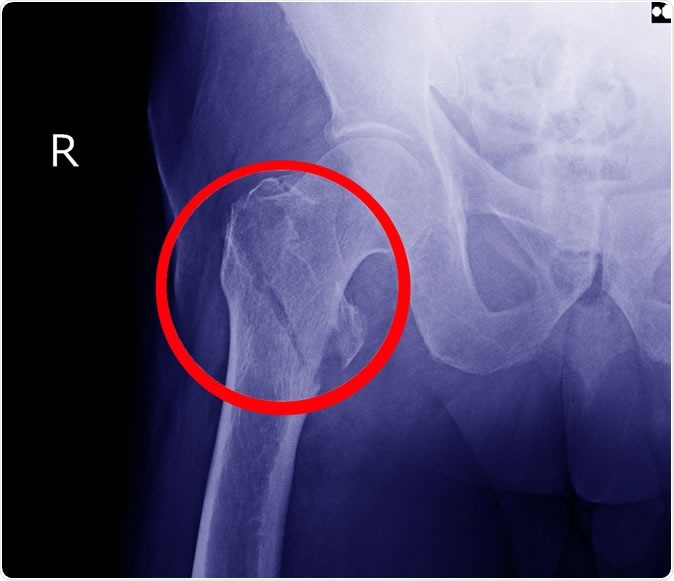
Housework, light walking reduces fracture risk after menopause
In a new study, even light physical exercise such as sweeping or mopping floors has been found to reduce the risk of fractures in general, and of hip fracture in particular, in women past menopause.
The study, published in JAMA Network Open on October 25, 2019, offers the most complete overview of the relationship between fractures and exercise in older women so far. The striking finding is that even modest exercise reduced the risk of fracture following menopause, which is a common cause of reduced independence, limitation of physical activity, and a higher risk of death.
About 1.5 million American women break a bone every year, with about 14% of these breaks involving the hip joint. The resulting disease is associated with costs totaling $12.7 billion in health care. Moreover, up to one in five elderly women eventually die of complications following a hip fracture.

Hip fracture X-ray. Image redit: Richman Photo / Shutterstock
The study
The researchers took data collected from over 77,000 women aged 50-79 years, all past menopause, who participated in the Women’s Health Initiative, over a 14-year period. The mean age was 63 years. During this time, at least one fracture occurred in a third (33%) of the group.
The current study looked separately at forms of physical activity occurring in a recreational setting, at home, or walking, along with the time spent sitting. The participants reported their levels of activity, with how long each episode or task lasted, and the number of times it was done per week. Recreational exercise was classified as usual into mild, moderate and strenuous, as per usual guidelines. Non-recreational activities included house and yard work. Sedentary behavior was also measured by the time spent sitting at work and at other times, and lying down.
The researchers classified the women by the amount of exercise they did, whether at home, while walking, or recreationally. They then looked at the correlations between total, mild, moderate to vigorous activity, and walking, with risk of hip fracture, and wrist or forearm fractures. They also examined the association between sedentary behavior and total fractures.
Fracture risk
Women in the highest category had about 35 minutes of household or leisure activity each day, on average, but had an 18% lower risk of hip fracture compared with those who were least active. Overall fracture risk was 6% lower.
Even mild activity reduced overall fracture risk by 9%, and the risk of a clinical break in a vertebra, or spinal bone, by 13%. The latter is an important finding because spinal breaks carry a poor prognosis in elderly women, and intense physical exercise is not required to reduce the risk.
Women who walked the most had a 12% lower risk of hip fracture, while the next lowest category had a decrease of 8%. The risk also fell by 18% with mild activity, 12% with moderate or vigorous activity, and 10% with yard work.
On the other hand, women who were the most active had a 26% increase in knee fracture risk. Moderate to vigorous activity increased the risk of wrist or forearm fracture by 9%.
Sedentary behavior
When women spent over 9.5 hours a day sitting or lying, as compared to less than 6.5 hours a day, there was a 4% increase in total fracture risk, 9% for spinal fracture, 7% for fracture at the wrist or forearm, and 10%) increase in total fracture risk. However, if adjusted for the total physical activity, the increase in fracture risk vanished.
Earlier research
In 2008, the Physical Activity Guidelines Advisory Committee found a 36% to 68% lower risk of hip fracture in people who were more physically active. In 2018, the revised guidelines confirmed this finding. However, like most other studies, physical activity was taken as a composite measure, including all types of recreational, workplace and domestic activity.
Implications
The paper joins several others from the same study, which join to confirm the health advantages of physical activity even when the exercise doesn’t conform to the current guidelines. The fact that sweeping or folding laundry, and doing yard chores, with other simple household tasks, apparently also reduces the risk of fractures, is a welcome revelation to many women who can’t get out of the house as often as they could wish but are busy with home and garden for a large part of the day. It is also a clearly important message to public health policymakers, since women of this age often do such tasks that are now found to be beneficial to them.
The take-home message for older women is, according to researcher Michael LaMonte, to “sit less, move more, and every movement counts.” The study limitations are obvious, including the known fact that people tend to report less sedentary time than actually occurs, as well as a higher level of physical activity. It should also be remembered that the risk of fracture is about 0.8% in women aged 65 to 69 years over a five-year period, and therefore the absolute reduction in the number of cases with physical activity is likely to be low, though still meaningful.
Journal reference:
LaMonte MJ, Wactawski-Wende J, Larson JC, et al. Association of Physical Activity and Fracture Risk Among Postmenopausal Women. JAMA Netw Open. Published online October 25, 20192(10):e1914084. doi:10.1001/jamanetworkopen.2019.14084, https://jamanetwork.com/journals/jamanetworkopen/fullarticle/2753526






















.png)










No hay comentarios:
Publicar un comentario